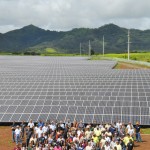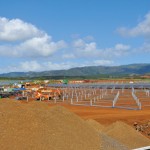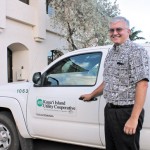Powering Up
Under the leadership of David Bissell, KIUC will produce half of Kauai’s daytime energy needs through renewable sources by next year. And there are plans for more
Kauai is well on its way to harnessing half its energy needs from natural resources in the next five years. It’s an ambitious goal for Kauai Island Utility Cooperative (KIUC), as its initial target was 2023.
“We’re optimistic we’ll be ahead of that,” says David Bissell, KIUC president and CEO.
Since he landed his current position in 2010, his committed efforts toward sustainable energy, along with the co-op’s board members and approximately 150 employees, has helped the island achieve the highest percentage of solar projects in the state.
- KIUC employees in front of the completed Koloa solar project | Photo courtesy of KIUC
- Construction of the 12-megawatt photovoltaic system in Koloa | Photo courtesy of KIUC
- David Bissell at KIUC headquarters Coco Zickos photo
“I think we’ve really transformed the island,” says Bissell.
The first large-scale solar project (6 megawatts) was built next to KIUC’s Port Allen plant and has been in operation about two years. It is a joint project with Alexander & Baldwin, which owns the land and receives tax incentives for supplying power to the co-op.
Since then, a photovoltaic system twice as big (12 MW) was developed by KIUC on land leased from Grove Farm Company in Koloa. And the next 12-MW project, on state land (Department of Hawaiian Home Lands), currently is underway in Anahola and is expected to be online next year.
These three solar resources alone are expected to provide more than half the island’s daytime energy needs.
Bissell knew the timing was right financially to bring all three projects to fruition. Not only did the co-op take advantage of tax benefits, but the price of solar panels also has declined in recent years.
Clean, inexpensive renewable energy like this is important to Bissell, and it shows.
The co-op has been introducing a number of other projects that should bring the island’s overall consumption to almost 40 percent renewable energy within the next year.
Aside from a handful of smaller-scale solar projects already furnishing power, such as the 1-MW photovoltaic system in Kapaa, KIUC has a purchase power agreement (a contract to buy electricity from the entity generating it) with independent developer Green Energy Team to grow woody albizia to be burned for energy in Knudsen Gap by 2015. It would supply some 7 MW of power that, unlike solar, would be usable 24 hours a day.
Another addition to the renewable resource supply that may boost the natural energy percentage even higher at 25 MW would be a proposed pumped storage hydro plant that recently received preliminary approval by the state Board of Land and Natural Resources. The system would use photovoltaic power to pump water from an already existing reservoir on the Westside to an existing reservoir higher upland during the day. At night, the water would be released to the lower site to harness nighttime energy needs. This kind of operation has been used effectively and efficiently since the 1800s.
“It’s a proven technology,” notes Bissell.
The project still needs to undergo a thorough environmental assessment and permitting process, and wouldn’t be online until 2019. “But once it’s there, it’ll be an asset to the island for 100 years or more,” says Bissell.
There always are a number of projects like these in the pipeline at KIUC, which keeps Bissell’s job exciting and interesting.
“It’s neat working with cutting-edge people in the industry,” he says.
But there are many challenges he must face, including projects that aren’t completed for various reasons, and some that should be finished in a year can take three or more.
“Developing any project in Hawaii is hard,” he admits. “Everything is frustratingly slow to get done. But you can’t be deterred.”
He also understands how frustrating it is to be aware of other natural resource solutions when the technology isn’t available yet.
Consider the ocean, for example, as an obvious choice for harnessing energy. “Logically, you’d think there ought to be a breakthrough,” he says. “It’d be a huge opportunity on an island.”
But even though there are many projects underway that aim to tap into wave energy, they are not yet commercially or financially viable, as lenders are less inclined to participate.
“They won’t lend money to a science project,” notes Bissell.
Still, he’d love to see it happen eventually.
Bissell has been drawn to the field of energy for quite some time. Originally from a rural town outside Buffalo,
N.Y., he graduated with a degree in accounting and finance from State University of New York at Brockport. His first job out of college was as a cost accountant for a manufacturing facility in Rochester, N.Y. He switched to energy after obtaining an MBA from Kelley School of Business at Indiana University. He worked at a large co-op in Indiana before moving to Cincinnati to work at Cinergy.
“I always kind of had a sweet spot for co-ops,” he says.
Looking for something new in 2006, he spotted the available CFO position at KIUC and was soon moving to the Garden Isle.
“This is a unique place, where there’s a lot of opportunity to make a difference,” he says.
And he’s certainly made quite a difference, especially in the last four years.
“We’re on an island, so everything you do is contained. It’s a unique chance to make something happen that can fundamentally change the life of people for years,” adds Bissell who with wife Carla has a 21-year-old daughter, Kathleen, along with three poi dogs — Boo, Violet and Wally.
“It hasn’t been easy, but it’s getting there.”
cocomidweek@gmail.com






